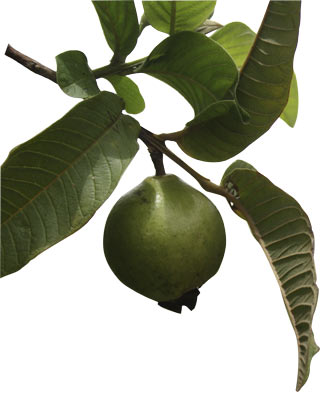Tropical Fruit
Pineapple and Strawberry Guavas

Unless you planted them yourself, many people would walk right by these small, shrubby trees. It is when they start dropping their fruit, though, that you might take notice. Although they are both known by the common name guava, there are two distinct species of guavas that grow in our gardens.
Commonly called the pineapple guava, and formerly known by the botanical name Feijoa sellowiana, the more accurately named Acca sellowiana is ripening its fruits right now. They are a pale gray to yellowish green when ripe and a sniff will tell you that they are ready. Their aroma is somewhat fruity, somewhat spicy. Their flavor is pretty bland, though, with hints of pineapple. Fruits are about three inches long and the tough, warty rind encloses the seedy flesh. The seeds are small and many enjoy eating the fruits out of hand, seeds and all. Many cooks, however, process the pulp through a food mill to remove the seeds for jam and other sauces and preserves. Try the puree in your favorite muffin or cake recipe to add moisture and exotic flavor.
Besides providing a tasty harvest, once you see the pineapple guava, you may find it a handsome addition to the landscape. Usually growing as a multi-stemmed shrub or small tree to 20 or so feet, the evergreen foliage can be a nice foundation for other plantings. Leaves are a glossy dark green above with a white underside due to a dense covering of hairs. The flowers, too, can be ornamental. They are small, only about an inch across, but they have white petals, stained purple inside, and numerous dark red stamens topped with yellow anthers. Attractive to birds because of their show, the petals are also sweet and edible. Humans can take a lesson from their avian friends and include the flowers in salads or as a garnish on cakes and other sweets. Pineapple guava was among the many species of exotic plants that were first cultivated in our area by the pioneering plantsman Francesco Franceschi. His nursery catalog from 1906 lists it as one of his introductions.
Strawberry guava belongs to a different genus entirely, although it is in the same family-Myrtaceae-as the pineapple guava. Psidium cattleianum also grows as a large shrub or small tree, 10-15 feet in height. Its slender trunks are smooth with blotches where the older brown bark peels off to reveal the lighter inner layer. The wood is hard and handsome when made into walking and massage sticks or other wood crafts. Also evergreen, strawberry guava has glossy, leathery leaves. The new growth will be reddish and mature foliage deep green. Its flowers are about an inch across and notable for the many white stamens that give them a puff ball look. The fruits are smooth, round, and about one to one-and-a-half inches in diameter. They are deep purplish red, sweet, and, again, full of small seeds. Delicious fresh, the plethora of seeds may dictate that you pulp the fruits to remove them before enjoying their flavor in jams and purees or to flavor cold drinks such as lemonade or sangria. Some fruit may ripen throughout the year, but the main crop is in late summer.
Both of these species have become somewhat weedy and invasive in Hawai’i but are easy to control here. There is one more species that grows and sets fruit more reliably in the tropical environs, like Hawai’i, than it does in our cooler coastal and frosty interior climes. It is Psidium guajava and may go by the name guayaba or just guava. Its growth is similar to strawberry guava, although if it is in a suitably warm and irrigated spot, it can reach 25 feet in height. Its fruits are yellow-skinned, about three inches long with juicy (and, yes, seedy) pulp. Interestingly, there is much variation in the color of the flesh as it can range from white to pink and even yellow. Unless you have a particularly warm and protected spot, guayaba will not likely succeed on the South Coast.
Even if you don’t have the space to grow guavas, you can find their fruits at local Farmers Markets when they are plentiful. Neighborhood food exchanges are another place to search them out. To purchase plants, check with your area nursery, but you may have to go online to firms that specialize in tropical fruits.



